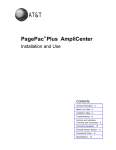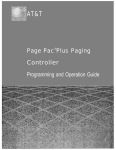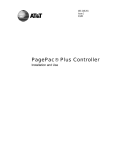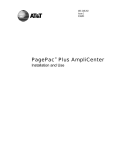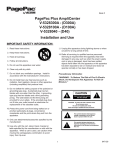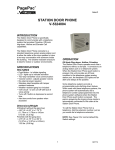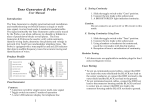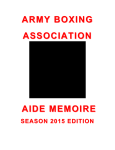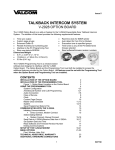Download Valcom V-5328100 Specifications
Transcript
PagePac ® by ISSUE 2 PagePac Plus AmpliCenter V-5328020/V-5328100/V-5328300 Installation and Use 947169 Installation Steps Note: If installed next to other equipment, including the PagePac Plus Controller and Zone Expansion Units, leave at least four inches space above and below for proper ventilation. 1. Mount the PagePac® Plus AmpliCenter to either the wall (Figure 1), cabinet, or a 19 inch rack (Figure 2). SIDE VIEW 105 - 120 VAC 210 - 240 VAC 50 - 60 Hz Figure 1. Wall Mounted Hardware FRONT DETAIL 1.750 TYPICAL PagePac Plus R PagePac Plus R Ampli Cen ter D300 AmpliCenter D300 19'' COMBINATION PAN HEAD PILOT POINT # 10 - 32 (TYPICAL) REAR DETAIL POWER STRIP Figure 2. Rack Mounted Hardware 2 947169 2. Connect music input wires to Left, Right, and Ground terminals, if stereo, or Left and Ground, if not (see Figure 3). Note: The optional audio background music source can be a CD or tape player, AM, FM, or commercial radio, or other audio device. Figure 3. Music Input Connections on AmpliCenter 3. Hookup speaker cable to AmpliCenter (see Figure 4). Note: If more than one speaker cable is routed to the AmpliCenter, a connector block is necessary. Refer to sample wiring diagrams on page 8. It is recommended that 22GA shielded wire be used. DO NOT hook up speaker wires with AmpliCenter power plug connected! Figure 4. Speaker Connection on AmpliCenter 4. Connect host telephone system to Amplicenter (see Figure 5). 5. Set the AmpliCenter Telephone Mode Selection Switch (see Figure 6) to match the page output type of your telephone system. 6. Insert power cord into AmpliCenter and into wall outlet (see Figure 7). 7. Test paging zone served by the AmpliCenter by dialing paging telephone extension or use microphone. 3 947169 A M P L IC E N T E R P A G E M U S IC IN D N G 1 C G NI R PI T D O U T P U T D M IC G S W IT C H P A G E IN P U T L With a microphone, hook the mic switch to C1 and Grd, and the mic output to Tip and Ring. M IC O O O R Y R Y R Use Tip and Ring if connecting to a Loop Start or Ground Start interface port in host telephone system. S P N U O L O L G NI K C U D T E R M IN A L S X O V E G A P L E V E L T U P NI T F E L T H GI R D N U O R G C 1 IN PI T G NI R L O W F R E Q C U T -O F F Use Tip and Ring if installing to an existing paging system (low voltage output), VOX activated. O U T R E W O P D A O L R E V O T U P T U O D E C N A L A B N U D E S S E C C A E G A P 7 0 V T O C O N T R O L L E R U N IT D N U O R G 0 d B m O U T D N U O R G 1 0 5 - 1 2 0 V A C 2 1 0 - 2 4 0 V A C 5 0 - 6 0 H z B A C K P A N E L T R A T T R A T S D Z I H P O S M H O 0 0 6 P O Note: Connect the 4-wire RJ-11 type plug (used with telephones) to the Page Input connector (far right), or use the Page in terminals. U S E o r C O N N E C T O R P A G E -IN O P T IO N S H O S T T E L E P H O N E S Y S T E M T IP A N D R IN G F R O M L O O P S T A R T O R G R O U N D S T A R T P O R T E X IS T IN G P A G IN G A M P L IF IE R , L O W V O L T A G E O U T P U T T O T IP a n d R IN G Figure 5. Host Telephone System Connection Figure 6. Telephone Mode Switch Setting Note: Do not use extension cords or plug into locally, “safety-fused” outlets. P A G E IN 105 - 120 VAC 210 - 2 4 0 VAC 50 - 60 Hz 6 F O O T P O W E R C A B L E Figure 7. Power Cable 4 947169 Note: If no page is heard, refer to the troubleshooting Guidelines. 8. Adjust sound levels using AmpliCenter controls, if necessary. Using a small standard screwdriver, make the following adjustments (see Figure 8). Figure 8. Test Page Adjustments 1. Adjust the Low Frequency Cut Off control. This control cuts out the low frequency bass so that horns and small speakers are not over-driven and distorted by excessive bass energy. Cut off frequency is continuously adjustable from 50 Hz (full CCW rotation) to 400 Hz (full CW rotation). 2. The Page VOX (voice activation) sensitivity is turned fully counterclockwise if the Dry Loop feature is not used. 3. Adjust Music Input Level. Clockwise rotation will increase the level. Listen and set to a comfortable level. 4. Using a telephone from the host system, dial the paging extension. Speak into the telephone in a normal manner. Your voice should be heard from all connected speakers. the AmpliCenter Page input has an automatic level control (ALC) which keeps loud voices and normal voices output at the same level. Beware of paging from a telephone directly under a loudspeaker; feedback howl can occur. (A feedback eliminator will solve this problem). 5. Readjust Music input level to the desired loudness relative to Paging loudness. 6. Some loudspeaker taps may have to be readjusted to get even coverage at all locations. be sure that the final speaker tap setting totals do not exceed the power rating of the AmpliCenter. 7. Adjust Music Ducking level. this feature allows music to continue to be heard during a Page, but at a reduced level. The range is from less than 40 dB (full CCW) to -6 dB (full CCW). If music-in is not connected, set to full CCW. 5 947169 Troubleshooting Some common problems encountered when the paging system is not operating are described below. Check each item in the order listed. 1. No AC power to AmpliCenter. 2. Host telephone system failure. 3. Host system page port failure. 4. A hardwire disconnect between host system and PagePac® Plus. 5. AmpliCenter switch settings tampered with. If the problem has not been resolved by checking the preceding items, follow the steps described in Table 1. Table 1. Troubleshooting Table Problem Corrective Action Page access from telephone system working, but page is not heard. No power to AmpliCenter. Host system not passing call through to AmpliCenter. Telephone mode selection switch not set correctly for host telephone system. Ground start - Tip and Ring reversed or AmpliCenter not grounded. Audio signal not reaching speakers. Check wiring at AmpliCenter. Verify Page Accessed LED is on. Background music cannot be heard. Input level not set correctly. Adjust music input level on AmpliCenter. No power to music source. Verify power is on. Radio off station. Adjust tuner. Music input wires crossed, with signal grounded out. Distorted, garbled, or raspy sound from all speakers connected to AmpliCenter. Short circuited speaker leads. Separate. Music input level too high. Turn down. Speaker transformer shorted. Replace. Failed AmpliCenter. Return for repair. Green power LED off. AC outlet receptacle is not live. Check outlet circuit breaker or use another outlet. Power cord is loose. Failed AmpliCenter. Return for repair. Page access LED won’t go off. Page VOX too sensitive. Adjust. Cl lead is grounded. If loop start or ground start, check that only 2 wires (Tip and Ring) are connected by the modular plug cord. 6 947169 Controls and Indicators, Terminals and Connectors Figure 9 shows the controls and indicators, terminals and connectors on the rear panel of the AmpliCenter. Table 2 identifies them by function. PAGE INPUT GND TIP RING C1 LOOP START DRY LOOP HI Z DRY LOOP 600 OHMS GROUND START PAGE VOX PAGE ACCESSED UNBALANCED OUTPUT OVERLOAD POWER DUCKING INPUT LEVEL C1 RIGHT - MUSIC IN TIP + PAGING IN LEFT LOW FREQ CUT-OFF 70V OUT GROUND TO CONTROLLER UNIT RING 0 dBm OUT GROUND 1 0 5 - 1 2 0 V A C 2 1 0 - 2 4 0 V A C 5 0 - 6 0 H z GROUND A M P L IC E N T E R Figure 9. AmpliCenter Controls and Indicators, Terminals and Connectors Table 2. Controls and Indicators, Terminals and Connectors 1. AC Power in: 105 - 120 VAC, 210-240 VAC, 5OW Hz, (voltage auto-selectable within unit). 2. 0 dBm out, an auxiliary output that differs from the main 70.7V output in that it is a low level (0 dB), 600 ohm balanced output used for driving a remote or off-premises amplifier. 3. DC Power, and 70V audio out to Controller (used only if Controller is also installed). 4. Low frequency cut-off screw-type adjustment pot. Attenuates low frequencies so that horns and small speakers are not overdriven by excessive bass energy. Cut off frequency is adjustable from 50 Hz (full CCW) to 400 Hz (full CCW). 5. Music In: left and/or right channels with ground. Paging In: redundant paging input (ground, C1, tip, and ring). 70V Out: Balanced output used for terminating the loudspeaker wiring. 6. Screw adjustable potentiometers: VOX sensitivity level, Music ducking (mute level for music during voice page). Music level for various music sources. 7. LEDs: Green - power on, lights when AC line voltage is applied to AmpliCenter. Red - overload, lights when the AmpliCenter output exceeds its output power rating. This can occur when total speaker load is greater than the output rating, or when speaker wiring is shorted. Red - unbalanced output, indicates when one speaker lead is accidentally shorted to ground. Green - page accessed, lights when voice paging is active. 8. Telephone system mode switch: dry loop 600 ohms, dry loop Hi Z, ground start, or loop start. 9. Page input from host telephone system or Controller RJ11 connector: paging audio and control. 7 947169 Connecting Speakers 1. Locate and mount all speakers in accordance with the floor plan drawing for this installation. 2. Connect each speaker to the appropriate home run or speaker-to-speaker wiring scheme as shown on the wiring plan (see Figure 10). 3. Test speaker wiring for short circuits. Measure the resistance of each home run wire run with an ohmmeter. Any pair indicating a value of less than 15 ohms must be rechecked for possible shorted wiring or speakers. Correct any problems and retest. Note: If paging zones use the talkback feature (available only when used with PagePac® Plus Controller), cabling must be shielded and grounded at the AmpliCenter connector, not the speaker. Maximum 2 speakers per zone with talkback. HOME RUN METHOD SPEAKERS R66B TW O WIR E S PagePac Plus R AmpliCenter D300 AMPLIC EN T ER TWO WIR E S 66-TYP E C ONN E C TI ON B L OC K TWO WIR E S R66B SPEAKER TO SPEAKER METHOD SPEAKERS PagePac Plus R AmpliCenter D300 AMPLIC EN T ER Figure 10. Speaker Run Methods 8 947169 Example System Setups Figure 11 illustrates the interconnection between the AmpliCenter and the Controller, if used. Figure 12 illustrates the interconnection of two or more AmpliCenters. A M P L IC E N T E R 105 - 120 VAC 210 - 2 40 VAC 50 - 60 Hz P A G E IN S E T M O D E S W IT C H T O D R Y L O O P 6 0 0 O H M P O W E R a n d 7 0 V A U D IO T O C O N T R O L L E R F R O M A M P T O Z .E .U . R S -2 3 2 T O P C (O P T IO N A L ) 0 d B u 0 d B m N .B . T O A A A M P C O N T R O L L E R T E L E M O D E S E L E C T T O T E L S Y S IN T E R F A C E T O T E L E P H O N E S Y S T E M P O W E R , C O N T R O L , a n d 7 0 V A U D IO to Z O N E E X P A N S IO N U N IT S , IF A N Y Z O N E C O N N E C T O R (1 -8 ): 7 0 V A U D IO O U T , A N D C O N T R O L S IG N A L IN o r O U T . Figure 11. AmpliCenter Interface with PagePac Plus Controller PAGE INPUT MUSIC INPUT GND TIP RING C1 DRY LOOP 600 OHMS DRY LOOP HI Z GROUND START LOOP START C1 DUCKING - MUSIC IN PAGE VOX + PAGING IN INPUT LEVEL 70V OUT RING TIP LOW FREQ CUT-OFF LEFT GROUND RIGHT TO CONTROLLER UNIT GROUND 0 dBm OUT GROUND 105 - 120 VAC 210 - 240 VAC 50 - 60 Hz PAGE ACCESSED UNBALANCED OUTPUT OVERLOAD POWER FIRST AMPLICENTER TO HOST TEL. SYSTEM (USE EITHER METHOD) AC POWER CONNECTION TO HOST TEL. SYSTEM PAGING CONNECTION NEXT AMPLICENTER TO SPEAKERS AC POWER CONNECTION C1 PAGE INPUT MUSIC INPUT GND TIP RING C1 DRY LOOP 600 OHMS DRY LOOP HI Z GROUND START LOOP START - MUSIC IN DUCKING + PAGING IN PAGE VOX 70V OUT INPUT LEVEL LOW FREQ CUT-OFF LEFT GROUND RIGHT TO CONTROLLER UNIT RING TIP 0 dBm OUT GROUND 105 - 120 VAC 210 - 240 VAC 50 - 60 Hz PAGE ACCESSED UNBALANCED OUTPUT OVERLOAD POWER NEXT AMPLICENTER GROUND Note: If the AmpliCenter is used with the PagePac® Plus Controller, refer to the Controller Installation and Use Guide for detailed instructions. SET TO DRY LOOP 600 9 TO NEXT AMPLICENTER TO SPEAKERS Figure 12. Series AmpliCenter Without Controller 9 947169 The Dry Loop 600 Ohm is a four wire interface consisting of a dry audio pair with a 600 Ohm impedance and a control pair. The page input is activated when the control pair receives a contact closure from the host equipment, connecting Cl to ground. The Dry Loop page input can also be activated by the presence of page input audio signals that exceed a set threshold. This threshold is set by the page VOX adjustment; clockwise rotation lowers the threshold and makes R more sensitive. Adjust by experimentation to account for various line loss and noise. This feature is beneficial for (amplified) microphone sources that don't have a Music/Page control contact, or for remote AmpliCenters. Dry Loop Hi Impedance is used to interface with parallel multiple units. Input impedance is 100K Ohms. Otherwise, the same as the 600 Ohm dry loop operation. Note: Ground start interface requires common ground between paging input and telephone system by direct line or other common grounding methods. The Ground Start mode is a two wire interface and has a 600 Ohm input impedance. When a trunk is accessed, a momentary ground is sent to the ringside of the pair by the host equipment, loop current is detected and the tip-side of the pair is closed. Disconnect supervision of the ground start mode is accomplished by monitoring the loop current. The Loop Start mode is two wire interface and has a 600 Ohm input impedance. The host equipment draws loop current from the talk-battery which is supplied by the AmpliCenter. Disconnect supervision of the loop start mode is accomplished by monitoring the loop current. TECHNICAL ASSISTANCE When calling, have a VOM and a telephone test set available and call from the job site. Call (540) 427-3900 and ask for PagePac Technical Support, or call (540) 427-6000 for Valcom 24hour Automated Support or visit our websites at http://www.pagepac.com and www.valcom.com. Should repairs be necessary, attach a tag to the unit clearly stating company name, address, phone number, contact person, and the nature of the problem. Send the unit to: Valcom, Inc. PagePac® Repair Dept. 5614 Hollins Road Roanoke, VA 24019-5056 10 947169 Specifications Table 4 describes the specifications of the AmpliCenter D20, D100, and D300 models. Table 3. AmpliCenter Specifications Features ■ Telephone Paging Access: The AmpliCenter accepts inputs from telephone system (PBX) ground start or loop start trunk ports, dry loop 600 ohm page ports, dry loop (hi Z), or amplified microphones. ■ Music interface: The AmpliCenter is the unit to which the background music source (CD, radio, tape player) is connected, for distribution to the paging system. ■ Volume control: The AmpliCenter has music ducking (mute) level, music volume level, and bass control adjustment pots on the rear panel. ■ Remote amplifier connection: The AmpliCenter provides 0 dBm audio output for connection to a remote amplifier, which receives a contact closure control signal from the AmpliCenter. ■ D20: up to 20 Watts total speaker load, for a 70V constant voltage distribution system. ■ D100: up to 100 Watts, for a 70V constant voltage distribution system. ■ D300: up to 300 Watts, for a 70V constant voltage distribution system. ■ D20 and D100: 3-1/2 foot (8.9 cm) high x 19 foot (48.25 cm) wide x 5 foot (12.7 cm) deep. ■ D300: 3-1/2 foot (8.9 cm) high x 19 foot (48-25 cm) wide x 7.25 foot (18A cm) deep. Weight ■ D20: 5 1bs (11 kg); D1OO: 6 1bs (13 kg); D300: q 7 lbs (14 kg). Load Impedance ■ Minimum, D20: 250 ohms, D100: 50 ohms, D300:16.7 ohms. Frequency Response ■ 60 Hz to 16 KHz Total Harmonic Distortion ■ Less than 1%, at rated power, 60 Hz to 16 kHz. Hum and Noise ■ Less than 80 dB below rated output, 20 Hz to 20 kHz bandwidth, unweighted. Telephone Paging Access ■ Automatic Level Control: 15:1 compression ration above -15 dBm input; Gain Below Limiting Knee: 56 dB; ALC Attack Time: Less than 3 msec. Music Input ■ Sensitivity: 180 mV for rated output, single channel input. 90 mV with both inputs driven. ■ Impedance: 20 kohms, unbalanced, each input (left & right). Current limiting, thermal shutdown, short circuit, reactive load, and internal DC fault protection. Rated Power Dimensions Overload Protection ■ Approvals ■ RJ-11 Jack Specifications ■ Talk battery: 24 volts, loop start or ground start, negative voltage ring lead. ■ Impedance: 600 ohms and 100 kohms. C.S.A 950, NRTL/C. Temperature ■ 0 to 40°C (32°F to 104°F) operational; to +50°C (122°F) with forced air. Range ■ -20 to +70°C (28°F to 158°F) storage and shipment. Environmental Requirements ■ Locate in an area free of excess moisture, corrosive gases, dust, and chemicals. Humidity: 5% to 95%. (noncondensing) storage/shipment and operation. Altitude: sea level to 10,000 ft. (1048 to 648 millibars) operational, 40,000 ft. maximum shipment. Electrical, Power, and Grounding Requirements ■ 105-120 VAC, 50-60 Hz; or 210-240 VAC 50-60 Hz (automatic selection). ■ Outlet must be a 3-prong outlet, separate ground, not controlled by an on/off switch. ■ D20: 1 amp max., D100: 2.5 amp/1.25 amp max., D300: 8 amp/4 amp max. ■ A. Use the power cord supplied with the unit, or an equivalent cord that meets applicable safety codes. Do not cut or remove the third wire ground prong. ■ B. The attachment-plug receptacles in the vicinity of the product or system are all to be of a grounding type, and the grounding conductors serving these receptacles are to be connected to earth ground at the service equipment. 11 947169











